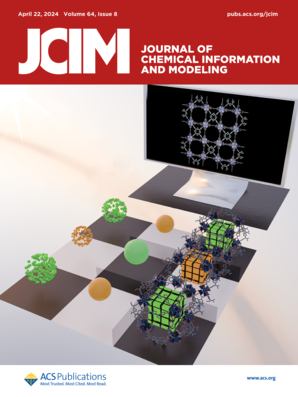包含药物结构和靶蛋白序列信息的抗逆转录病毒化合物的IFPTML多输出模型。
IF 5.6
2区 化学
Q1 CHEMISTRY, MEDICINAL
引用次数: 0
摘要
艾滋病毒等逆转录病毒在人类和其他生物体中引起重大疾病,使发现抗逆转录病毒药物成为一个关键的优先事项。虽然像ChEMBL这样的数据库包含有价值的信息,但它们的复杂性带来了挑战。该数据集包括8种病毒的约>40,000项测定,包括>50种生物活性参数,>0种靶蛋白,bbb80种细胞系,bbb60种测定生物和>770种病毒株。人工智能/机器学习(AI/ML)模型为加速ARV的发现提供了一种很有前途的方法。最近,我们使用信息融合摄动理论和机器学习(IFPTML)策略开发了ChEMBL ARV数据的AI/ML模型。然而,现有的AI/ML模型和我们之前的IFPTML实现都不能同时纳入病毒蛋白序列、菌株、细胞系、测定生物或病毒/人类突变。这一限制使它们无法预测对氨基酸序列变异(例如突变、变异体或新出现的菌株)的活性──鉴于已上市抗逆转录病毒药物中耐药突变的普遍存在,这是一个严重的缺陷。在这项工作中,我们提出了一个整合蛋白质序列描述符的增强IFPTML模型。我们计算并整合了ChEMBL中所有药物靶蛋白的序列描述子,这些序列描述子来源于逆转录病毒(HIV, FeLV, MMV, SIV等)的蛋白质组。该模型表现出稳健的性能,在训练和验证阶段的灵敏度(Sn)、特异性(Sp)和准确性(Ac)值在72.0到88.0%之间。我们分析了它对ChEMBL和其他文献来源中记录的蛋白质突变的预测。据我们所知,这代表了ARV发现的第一个统一的多条件,多输出模型,该模型系统地解释了蛋白质序列信息。本文章由计算机程序翻译,如有差异,请以英文原文为准。
IFPTML Multi-Output Model for Anti-Retroviral Compounds Including the Drug Structure and Target Protein Sequence Information.
Retroviruses such as HIV cause significant diseases in humans and other organisms, making the discovery of antiretroviral (ARV) drugs a critical priority. While databases like ChEMBL contain valuable information, their complexity poses challenges. The data set includes approximately >140,000 assays across eight viruses, encompassing >350 biological activity parameters, >50 target proteins, >80 cell lines, >60 assay organisms, and >770 viral strains. Artificial Intelligence/Machine Learning (AI/ML) models offer a promising approach to accelerate ARV discovery. Recently, we developed AI/ML models for ChEMBL ARV data using the Information Fusion Perturbation Theory and Machine Learning (IFPTML) strategy. However, neither existing AI/ML models nor our prior IFPTML implementation simultaneously incorporates viral protein sequences, strains, cell lines, assay organisms, or virus/human mutations. This limitation renders them ineffective for predicting activity against amino acid sequence variations (e.g., mutations, variants, or emerging strains)─a critical shortcoming given the well-documented prevalence of drug-resistance mutations in marketed ARVs. In this work, we present an enhanced IFPTML model integrating protein sequence descriptors. We computed and incorporated sequence descriptors for all drug target proteins in ChEMBL, derived from proteomes of retroviruses (HIV, FeLV, MMV, SIV, etc.). The model demonstrated robust performance, with sensitivity (Sn), specificity (Sp), and accuracy (Ac) values ranging between 72.0 and 88.0% in both training and validation phases. We analyze its predictions for protein mutations documented in ChEMBL and other literature sources. To our knowledge, this represents the first unified multicondition, multioutput model for ARV discovery that systematically accounts for protein sequence information.
求助全文
通过发布文献求助,成功后即可免费获取论文全文。
去求助
来源期刊
CiteScore
9.80
自引率
10.70%
发文量
529
审稿时长
1.4 months
期刊介绍:
The Journal of Chemical Information and Modeling publishes papers reporting new methodology and/or important applications in the fields of chemical informatics and molecular modeling. Specific topics include the representation and computer-based searching of chemical databases, molecular modeling, computer-aided molecular design of new materials, catalysts, or ligands, development of new computational methods or efficient algorithms for chemical software, and biopharmaceutical chemistry including analyses of biological activity and other issues related to drug discovery.
Astute chemists, computer scientists, and information specialists look to this monthly’s insightful research studies, programming innovations, and software reviews to keep current with advances in this integral, multidisciplinary field.
As a subscriber you’ll stay abreast of database search systems, use of graph theory in chemical problems, substructure search systems, pattern recognition and clustering, analysis of chemical and physical data, molecular modeling, graphics and natural language interfaces, bibliometric and citation analysis, and synthesis design and reactions databases.

 求助内容:
求助内容: 应助结果提醒方式:
应助结果提醒方式:


